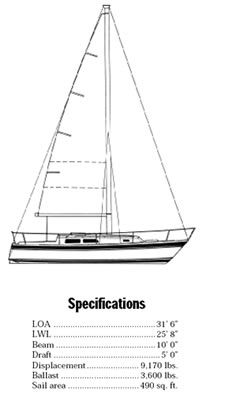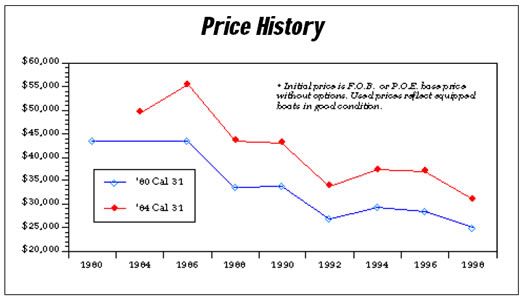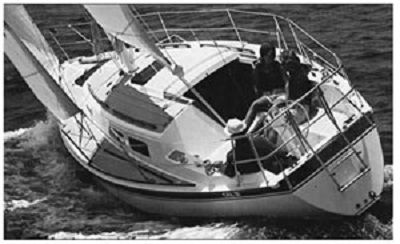The Cal 31 is the thirteenth Bill Lapworth designed Cal boat between 27′ and 34′ built by the Costa Mesa, California firm. Cal, a pioneer in fiberglass sailboat construction, later became a division of Bangor Punta Marine, whose boatbuilding group also included O’Day and Ranger. Cal boats went out of production in 1989. Cal and Bill Lapworth are best known for the breakthrough Cal 40, which many years ago began the trend toward moderately light displacement, fin-keel spade-rudder ocean racers.
The hull configuration of the Cal 31 is typical of Lapworth designs: shallow-bodied and round-bilged, with a fairly short fin keel, a shallow skeg, and a well faired high aspect ratio spade rudder. Production of Cal 31 began in the fall of 1978; 130 boats were built in the first three years.
The entire Cal line was heavily promoted as dualpurpose boats, the ubiquitous “cruiser-racer” which now seems to dominate the sailboat market. The company’s colorful, catchy ads were prominent in sailing magazines and were geared toward the affluent 30- to 40-year old consumer with a lot of experience. Surprisingly, many new Cal 31 purchasers were buying their first sailboat larger than small onedesign daysailers. One Cal 31 owner reported that the 31 was his fourth Cal boat. Cal 31 owners typically spend 70% of their sailing time daysailing, 20% short-term cruising, and 10% club racing.
Owners report relatively few defects, but the ones they do report are recurrent, and almost exclusively associated with water getting where it’s not supposed to be—inside the boat. The most common problems with the Cal 31 are leaking stanchion bases, leaking chainplates, and leaking hatches. These are probably the most common warranty claims throughout the industry and are generally the result of the fact that adequate bedding to prevent leaks requires fairly careful work, can be messy, and takes time to clean up.
Construction
The hull of the Cal 31 is a solid hand layup. Cal hull weight, less ballast, is about average for performance cruisers of comparable length and beam, although total displacement tends to be lighter than average.
Exterior cosmetic finish is good. There is slight print through of the first layer of roving, and some pinholes appear in the gelcoat where surface blemishes have been patched.
The deck molding is plywood-cored in areas where heavy hardware is mounted. The cabin top is sandwich construction: Klegecell foam, cored with ply- wood inserts in the mast partner area. The cabin top under the deck-stepped mast is solid 3/4″ fiberglass.
The companionway of the Cal 31 is about its weakest design point. It is too wide and has a strong taper which allows drop boards to be removed by lifting a little more than an inch. The mating surface between the two solid teak drop boards is a simple square butt. In every Cal 31 we examined, daylight was visible between the two boards—in one case, almost 1/4″. Simple reverse bevels, or preferably, a stepped joint, would take about two minutes more to make and would be infinitely better in terms of water-tightness.
The companionway slide design is not waterproof. The optional sea hood is essential on any boat going offshore or sailing in areas with boisterous conditions.
The split backstay arrangement allows use of an integral centerline swimming ladder incorporated in the stern rail. Backstay chainplates are throughbolted, but fiberglass backing plates are used where we would prefer aluminum or stainless steel. The welded combination bow fitting and chainplate is through-bolted but lacks a backup plate. In fact, the only deck fittings, including winches and cleats, which utilize backup plates are the lifeline stanchions and bow pulpit.
As a rule, The Practical Sailor prefers to see metal backup plates on through-bolted fittings, even cleats and winches which are normally only subjected to shear loads. Overkill in the mounting of hardware is cheap insurance.
The hull-to-deck joint is made by chemically bonding the two moldings together. An extruded rigid plastic rubrail holder and soft vinyl rubrail insert cover the hull-to-deck joint on the outside of the hull.
The ballast keel is an encapsulated lead casting. The fiberglass-covered, high-density foam-cored rudder utilizes a stainless steel rudder stock.
The main structural bulkhead is teak-faced plywood, bonded to the hull with fiberglass fillets. To avoid hard spots, the bulkhead itself does not touch the hull. The mast is supported by a teak compression column which rests on a deep molded fiberglass floor timber, part of the molded floor pan, which is bonded to the hull.
Chainplates for the inboard shrouds are heavy stainless steel flat bar, properly bolted to the main bulkhead and other plywood webs. Inside the head locker, the chainplates are bolted through a web which is covered with the carpet-like hull liner before installation of the chainplates. We would prefer to have the chainplate and backup pads bear directly on the wood or fiberglass web, rather than on the hull liner.
The rig is a basic masthead sloop with single airfoil spreaders and double lower shrouds. Lower shroud terminations are inboard and about a foot from the molded fiberglass toerail. The Cal 31 utilizes a polyurethane coated Kenyon aluminum mast and boom. Although rope-to-wire tailspliced halyards are listed as standard, the boat we sailed had eye-spliced halyards.
The wire portion of the main halyard was too short to allow an adequate number of wire wraps around the winch. Other boats we examined had properly spliced halyards.
Water tanks are cast polyethylene, with flexible plastic hose piping. A definite plastic taste is imparted to the water by this system. The fuel tank is welded aluminum. Tanks and batteries are mounted under the cabin settees, below the waterline with the weight concentrated in the middle of the boat. This location utilizes a space often given over to lockers which in many boats tend to be wet from bilge water. The battery boxes are well secured, but it is difficult to remove the box covers to inspect the battery electrolyte level.
The Cal 31 is one of the few current production boats with a real bilge sump. Unfortunately, both the icebox and the shower drain through the bilge to this sump. Organic matter and food particles in icebox water quickly lead to smelly bilges. Soap residue from showers can gradually clog impeller-type bilge pumps, which could be a problem in the event of a serious hull leak.
Through-hull fittings below the waterline are bronze, recessed flush with the hull surface and well bedded but without backing blocks. Shutoff valves are glass-filled nylon ball valves originally developed for the chemical industry. Above-water throughhulls are nylon, with no provision for emergency shutoff. One owner we contacted had bronze seacocks installed on underwater openings, as he was leery of the standard nylon valves.
Handling Under Sail
Sailing performance of the Cal 31 is consistent with her performance-cruiser image. Most owners consider the boat somewhat tender. The boat does tend to bury the rail quickly in gusts about five knots above mean wind speed. On the wind, with 14 knots of breeze over the deck, the boat is on the verge of needing a short reef when sailed with a 145% genoa and full main.
The Cal 31 is not particularly wide, but her beam is carried well forward and aft. She therefore develops less weather helm when overpowered than a comparably-sized racing boat and will be a bit more forgiving of improper sail combination than a wider boat whose ends are more pinched.
The Cal 31 is a comfortable boat for a couple to handle. The boat we sailed had Barient 23 self-tailers instead of the standard Barient 21s. We would recommend the larger self-tailers instead of the standard winches on a boat that will be used for shorthanded cruising.
The Cal 31 will hold her own with other performance cruisers of comparable size. She is closer winded and faster than the Cal 29 in light air.
The Cal 31 has generally good handling characteristics under sail. She balances well and can be made to sail herself on the wind with judicious use of sail trim. The boat has a good, solid feel under sail, more like a 35-footer than a 31-footer.
Handling Under Power
The standard engine in the Cal 31 is a two-cylinder 16 horsepower Universal diesel. Earlier models were equipped with two-cylinder Volvo diesels. Owners consider the engine adequate power for the boat.
The instrument panel is mounted on the forward end of the cockpit, and includes gauges for alternator output, water temperature, and fuel level. There is an oil pressure warning light. An oil pressure gauge and a tachometer would be welcome.
The boat handles well under power, but the engine transmits substantial vibration to the hull. This vibration could be tiring if long periods of motoring are required.
Handling in forward gear is uncomplicated. Like most fin-keel boats, the Cal 31 turns in a very tight circle. Handling in reverse is more complicated. With the Volvo engine, owners report that the stern of the boat pulls sharply to starboard. Some owners of Universal-powered boats also report uncertain steering behavior in reverse. We find the steering reasonably predictable, but she does require a firm hand on the tiller or wheel to keep the rudder from going hard over once sternway is made. Gradual application of rudder in reverse prevents rudder stall, which could cause unpredictable steering.

Deck Layout
The initial reaction of most owners to the cockpit of the Cal 31 is that it is too small. Their response after living with it is that it is just about the right size. With either the wheel or the tiller, it is comfortable for a maximum of four when sailing.
There is a wide bridgedeck at the forward end of the cockpit. The roller-bearing mainsheet traveler, with its essential athwartships control lines, is located on the bridgedeck on older Cal 31s, but it was later moved up above the companionway.
There are two huge cockpit lockers. These would be more useful if divided into smaller spaces and if partitions were inserted to prevent gear from slipping under the cockpit, where it might fetch up against the engine.
The cockpit lockers have an excellent molded-in scupper arrangement which allows the leeward seats to drain at all angles of heel. Unfortunately, the boat has an inexplicable method of securing the locker lids. A line is attached to the underside of the starboard lid. This leads under the cockpit to a jam cleat which is reached through the port cockpit locker. The port locker has a similar arrangement which can only be released from belowdecks, in the galley. If the lockers are secured, one must go below, release the port locker hold-down, go back on deck, open the port cockpit locker, and release the starboard hold-down to get into the starboard cockpit locker.
The logic of this system escapes us.
Access to the rudder stock head in wheel-steered boats is via a deckplate in the cockpit sole. If this were removed to rig emergency steering, a substantial amount of water could find its way below in rain or heavy weather.
The inboard shrouds provide a narrow sheeting base for jib leads but make it almost mandatory to go over the cabin top to go forward of the mast.
There is an anchor well at the forward end of the deck. This well contains a strong eyebolt for securing the bitter end of the anchor rode, an excellent idea. Connections for the pulpit-mounted running lights are under the deck immediately forward of the lid to the anchor well and will be subject to rapid corrosion from water finding its way below as well as to mechanical damage when stowing the anchor rode.
The stemhead fitting incorporates a roller, handy for stowing an anchor. There are no bow chocks. The anchor roller can be used as a starboard chock,although the lack of a fair lead to a bow cleat is a serious shortcoming. Anchoring with two anchors would be problematic without good bow chocks. The long inboard track for jib lead blocks provides for flexible sheet leads but should be augmented by a toerail-mounted track for greater variety. If genoas larger than 150% are used, the stock track will prove too short for optimal leads.

Interior
The Cal 31 has perhaps the most spacious and attractive interior in its class. It is the boat’s most outstanding feature. Belowdecks, it is hard to believe you are aboard a boat only 31′ long. “The interior sold us on the boat” was the most common owner response.
The forward cabin has large V-berths with an insert to form a huge double. There is a good sail bin under the port berth, and shelves at the foot of the berth. Most owners find the short hanging locker in the forward cabin useless. Most would prefer more drawers instead.
The foredeck-mounted hatch provides good ventilation and is big enough for sail bags, but its location requires that it be tightly secured when sailing to prevent water from getting below. Close attention will have to be paid to the water-tightness of the hatch if the berth below is to be kept dry.
The large head is comfortable and incorporates a shower. An overhead deadlight augments the ligh provided by the opening port. The door to the head also serves as the door to the forward cabin. When this door is used to shut off the forward cabin, the door to the large starboard hanging locker can be used to separate the head from the main cabin. The main cabin interior is rather dark due to the abundance of teak. This can be offset by a bright carpet.
The main cabin is huge. There is good storage in bins and alcoves behind the settees. A large magazine/ book rack on the bulkhead behind the fold-up table is inaccessible without folding down the table. There is no means of positively securing the table’s fold-down leg to the cabin sole. The leg could be accidentally kicked out of place when the table is in use, allowing it to fall down. The table is too small to accommodate even four with real comfort. The cabin is wide enough to utilize a permanently fitted table.
The main cabin sleeps three in a large single berth and an extension double. The deeply-tufted settee cushions look rich and are comfortable for sitting but are miserable to sleep on.
Cooks will appreciate the galley, which is excel- lent for a boat of this size. There is a large gimbaled stove with oven, well secured and capable of being latched in place in port. It is available in both alcohol and gas models.
The icebox top is one of the few we have seen which can reasonably double as a chart table. The icebox lids are insulated, but are poorly fitted, allowing a large gap—over 3/8″—between the two traptype lids. The lids are also usually not flush with the icebox top, a complication for doing smooth chart work.
There is a large-diameter tube for rolled charts which extends under the cockpit. With a good surface available for chart work, folded charts make much more sense.
The engine is reached for service by lifting out the companionway steps. The steps should have a positive latch to prevent their bouncing out of place in rough conditions. Engine access for maintenance is excellent.
Selection valves for the water tanks are located under the deep galley sink. This is typical of the wellthought out plumbing and wiring systems, which are generally well-bundled and usually protected from chafe when passing through bulkhead cutouts. Basically, the interior of the Cal 31 is one of the most livable and attractive we have seen in a boat of this size. Interior finish work is of very good stock boat quality.

Conclusions
The Cal 31 is one of the best designed and better executed 31-footers we have seen. Her interior is remarkable. She has a wide range of buyer appeal, selling to first-time sailboat buyers as well as to the more experienced. She is a reasonably good clublevel racer, yet a comfortable cruiser for up to four adults. Realistically, the boat will be used more for cruising and daysailing than for racing.
The Cal 31 was produced until 1985, and was very expensive when new. The 1980 base price was around $43,000, and delivered prices ran close to $50,000. The 1992 average price for that 1980 model is about $25-$26,000, making it considerably more expensive than other boats in this size range.







































